Last summer at a trail near Asheville, I watched an experienced hiker gracefully navigate rocky terrain without any shoes on his feet. While other hikers carefully picked their way over loose stones in heavy boots, he seemed to dance across the trail with perfect balance and awareness. That encounter introduced me to the world of barefoot hiking—a practice that’s both ancient and surprisingly modern, offering unique benefits while requiring careful preparation and respect for natural terrain.
Barefoot hiking represents more than just walking without shoes—it’s a return to our natural movement patterns and a deeper connection with the trail beneath our feet. After spending most of our lives in cushioned, supportive footwear, the transition to barefoot trail walking requires patience, preparation, and a complete rethinking of how we move through outdoor spaces.
Understanding the benefits, risks, and proper techniques of barefoot hiking can transform your outdoor experience, offering improved balance, stronger feet, and a more intimate connection with nature. For those interested in foundational outdoor skills that complement barefoot hiking, our hiking checklist covers essential preparation for all types of trail adventures. This comprehensive guide covers everything you need to know to safely explore this unique approach to hiking.
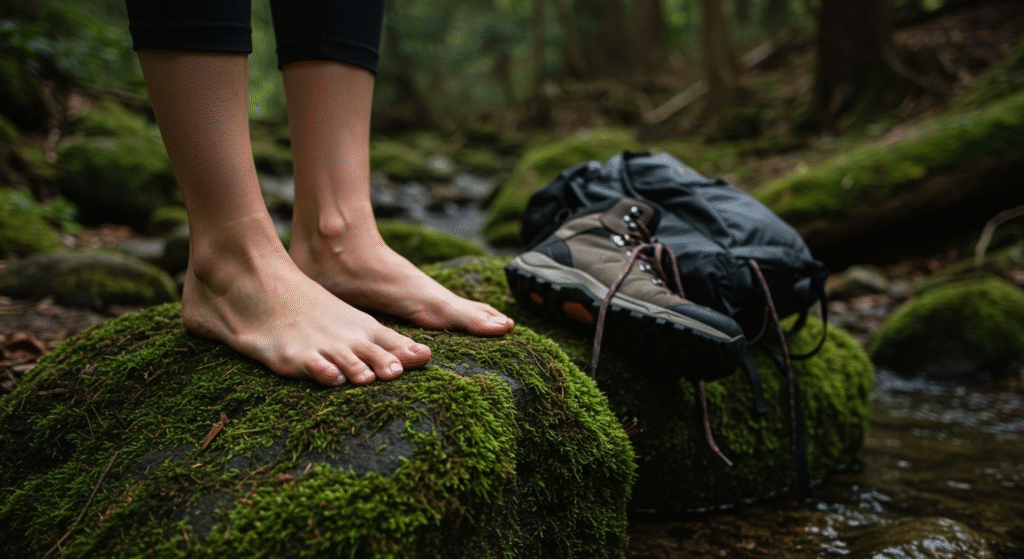
The Science Behind Barefoot Hiking Benefits
Enhanced Balance and Proprioception
The human foot contains over 200,000 nerve endings that provide constant feedback about terrain, balance, and movement. Modern hiking boots essentially numb these mechanoreceptors, reducing our natural ability to sense and respond to changing ground conditions. Barefoot hiking awakens these dormant sensory systems, dramatically improving balance and coordination.
Proprioception—your body’s awareness of its position in space—becomes dramatically enhanced when hiking barefoot. Without the artificial platform of shoes, your feet must constantly adjust to micro-changes in terrain, engaging stabilizing muscles throughout your legs, core, and even your upper body. This creates a full-body workout that traditional shod hiking cannot match.
Research shows that people who walk barefoot develop 40% stronger intrinsic foot muscles compared to those who exclusively wear shoes. These small but crucial muscles control arch support, toe alignment, and impact absorption—functions that hiking boots typically perform artificially.
Natural Movement Patterns and Gait
Barefoot hiking forces you to adopt more natural movement patterns that reduce stress on joints and improve overall biomechanics. When wearing shoes, most hikers develop a heel-strike pattern that sends shock waves up through the kinetic chain to the knees, hips, and lower back.
Barefoot hikers naturally adopt a midfoot or forefoot strike pattern, landing more softly and allowing the foot’s natural arch to act as a spring-loaded shock absorber. This biomechanical change:
- Reduces impact forces by up to 50% compared to heel striking
- Engages the calf muscles as natural shock absorbers
- Improves energy efficiency through better ground reaction forces
- Reduces stress on the knee and hip joints over long distances
Stride length naturally shortens when hiking barefoot, forcing a more measured, controlled approach that actually improves hiking efficiency. While you may initially move more slowly, the reduced energy expenditure from better biomechanics often results in less fatigue over longer distances.
Strengthened Foot Architecture
Years of wearing supportive footwear can weaken the intrinsic muscles that maintain foot structure and function. Barefoot hiking gradually strengthens these neglected muscle groups, improving overall foot health and function.
The longitudinal arch acts as the foot’s primary shock-absorbing mechanism, but supportive shoes prevent this natural spring system from developing strength. Regular barefoot activity strengthens the muscles and ligaments that maintain arch integrity, potentially reducing issues like plantar fasciitis and flat feet.
Toe strength and mobility improve dramatically with barefoot hiking. Modern shoes compress toes into unnatural positions, weakening the muscles responsible for balance and propulsion. Barefoot hiking allows toes to spread naturally, grip terrain, and function as they evolved to do.
For those interested in comprehensive foot care and hiking preparation, our How Should Hiking Boots Fit guide provides valuable insights into proper footwear, which becomes even more important when transitioning between barefoot and shod hiking.
The Gradual Transition: Building Barefoot Hiking Skills
Starting Your Barefoot Journey
The transition to barefoot hiking must be gradual and patient—rushing the process leads to injury and disappointment. Most adults have spent decades in supportive footwear, creating muscular imbalances and movement patterns that require time to correct.
Begin with indoor barefoot walking on safe, soft surfaces like carpet or yoga mats. Start with just 5-10 minutes daily, focusing on how your feet naturally want to move and land. Notice the difference in how you walk when freed from the constraints of shoes.
Progress to outdoor barefoot walking on safe surfaces like short grass, sandy beaches, or smooth dirt paths. These forgiving surfaces allow your feet to adapt gradually while building strength and callous formation. Spend 2-3 weeks developing basic foot conditioning before attempting any trail hiking.
Incorporate foot-strengthening exercises into your daily routine:
- Toe spreads: Actively spread your toes as wide as possible, hold for 10 seconds
- Arch raises: Lift your arch while keeping toes and heel planted (the “short foot” exercise)
- Calf raises: Strengthen the muscles that act as natural shock absorbers.
- Balance work: Stand on one foot with eyes closed to challenge proprioception
Choosing Your First Barefoot Hiking Terrain
Surface selection is critical for safe barefoot hiking progression. Start with the most forgiving terrain and gradually work toward more challenging surfaces as your feet adapt.
Ideal beginner surfaces:
- Soft forest paths with pine needles or leaf litter
- Grassy meadows and fields with short, even vegetation
- Sandy trails that provide cushioning and natural abrasion for callus development
- Smooth dirt paths without rocks, roots, or debris
- Moss-covered areas that offer both cushioning and interesting sensory experiences
Surfaces to avoid initially:
- Rocky or boulder-strewn trails can cause puncture wounds or bruising
- Areas with heavy debris, glass, or human-made hazards
- Extremely hot surfaces that can cause thermal burns
- Terrain with thorns, thistles, or aggressive vegetation
- Wet or muddy areas where visibility of hazards is limited
Distance progression should be conservative: Start with 0.5-1 mile barefoot sections within longer hikes, gradually increasing as comfort and conditioning improve. Many experienced barefoot hikers recommend no more than 10% weekly increases in barefoot distance.
Building Mental Resilience and Awareness
Barefoot hiking requires heightened awareness that many modern hikers have lost. Without the protection of shoes, you must constantly scan the terrain ahead, choosing foot placement with precision and care.
Develop “soft eyes” vision that takes in the broad trail ahead rather than staring directly at your feet. This panoramic awareness allows you to spot hazards while maintaining a natural walking rhythm and enjoying your surroundings.
Practice mindful walking by paying attention to the sensations under your feet—the temperature of different surfaces, the texture of various materials, the way your foot naturally adjusts to terrain changes. This mindfulness practice enhances both safety and enjoyment.
Accept discomfort as part of adaptation: Your feet will be tender initially, and some surfaces that seem manageable in shoes will feel challenging barefoot. This is normal and temporary, but pushing through significant pain can lead to injury.
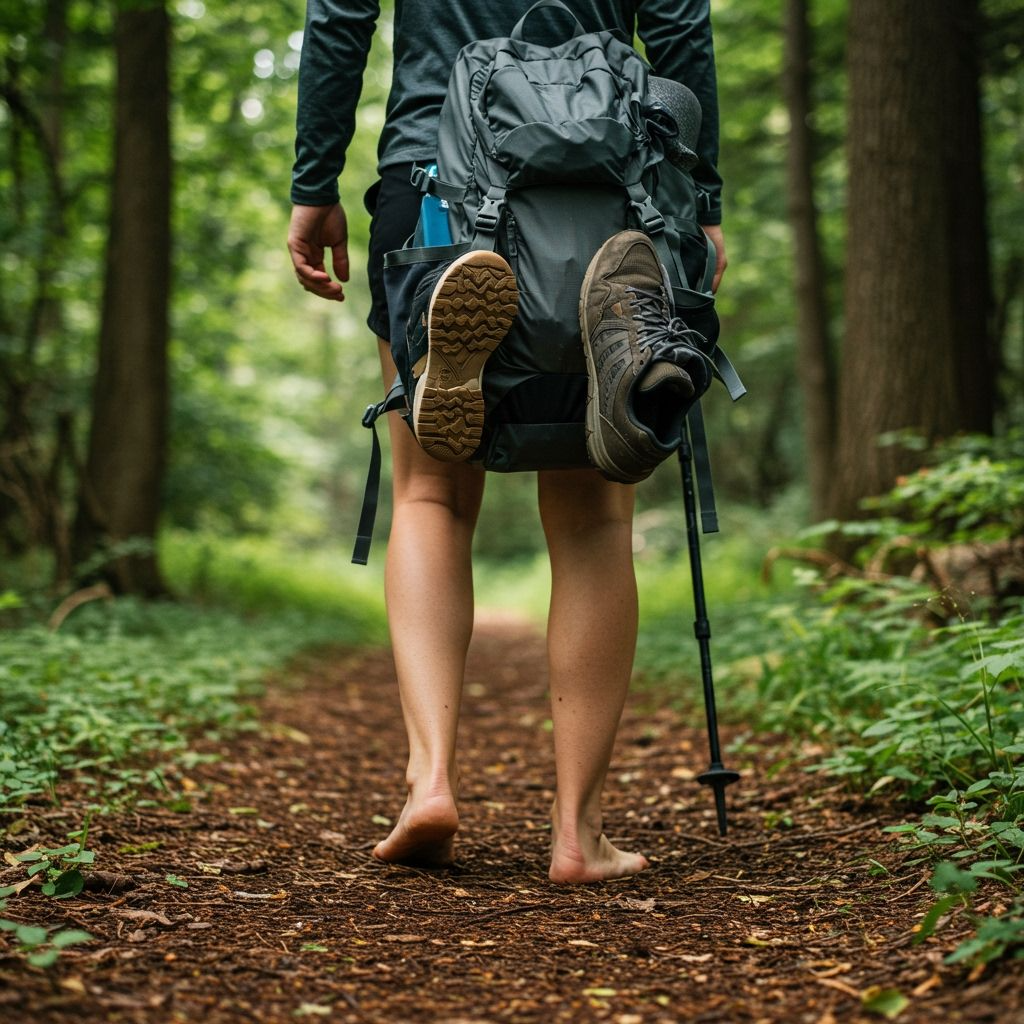
Safety Considerations and Risk Management
Common Hazards and Prevention
Sharp objects present the most obvious danger to barefoot hikers, but proper technique and awareness dramatically reduce these risks. The key is learning to read terrain and adjust your approach accordingly.
Glass and metal debris are primarily concerns on trails near roads, camping areas, or popular day-use sites. Always inspect these areas carefully and consider this an appropriate time to wear protective footwear rather than risking serious puncture wounds.
Thorns and plant hazards require regional knowledge and seasonal awareness. Learn to identify problem plants in your hiking areas:
- Blackberry and rose bushes with trailing thorns across trails
- Thistle and nettle species that can cause painful stings
- Cactus and desert plants in arid regions pose puncture risks.
- Poison ivy, oak, and sumac can cause severe contact dermatitis on the feet.
Insect and animal concerns include:
- Ground-dwelling bees and wasps are attracted to fallen fruit or flowers
- Ticks and chiggers in grassland and forest floor environments
- Snakes that may be difficult to see on trails, especially during warm weather
- Scorpions and spiders in desert and rocky environments
Temperature extremes pose serious risks:
- Hot surfaces can cause thermal burns in desert environments or on sun-baked rock
- Cold conditions increase the risk of frostbite and reduce tactile sensitivity.
- Snow and ice create slipping hazards and cold injury risks.
First Aid and Emergency Preparedness
Every barefoot hiker should carry enhanced first aid supplies specifically designed for foot injuries:
Essential items include:
- Tweezers for splinter and thorn removal
- Antiseptic wipes for cleaning wounds in field conditions
- Various bandage sizes, including knuckle and fingertip shapes that work well on toes.
- Moleskin or similar padding for pressure relief over tender spots
- Duct tape for emergency shoe repair or protective wrapping
- Emergency footwear, like ultralight sandals or even socks, for protection
Know how to handle common injuries:
- Puncture wounds: Clean thoroughly, assess depth, consider tetanus risk
- Cuts and abrasions: Control bleeding, clean wound, protect from further contamination.
- Thermal burns: Cool immediately with water, protect from further exposure
- Stings and bites: Remove stingers, clean the area, and monitor for allergic reactions
When to abort a barefoot hike:
- Any puncture wound that might contain debris
- Significant cuts that won’t stop bleeding
- Signs of infection, including redness, swelling, or warmth
- Severe pain that affects the normal walking gait
- Weather conditions that create unsafe temperature extremes
For comprehensive outdoor safety information that applies to all types of hiking, including barefoot approaches, our solo hiking guide covers essential safety protocols and emergency preparedness.
Legal and Practical Considerations
Most public trails allow barefoot hiking, but some locations have specific restrictions:
- National Parks may prohibit barefoot activity in certain sensitive areas
- Some state parks require footwear on designated trails for liability reasons.
- Private lands may have specific rules about appropriate attire, including footwear.
- Group-organized hikes often require participants to wear shoes for insurance purposes.
Social considerations include respecting other hikers’ comfort levels and understanding that barefoot hiking may draw attention or questions. Most outdoor enthusiasts are curious rather than critical, but being prepared to explain your choice helps promote understanding.
Practical backup planning means always carrying lightweight emergency footwear and having exit strategies if conditions become unsuitable for barefoot travel. Flexibility and adaptability are essential barefoot hiking skills.
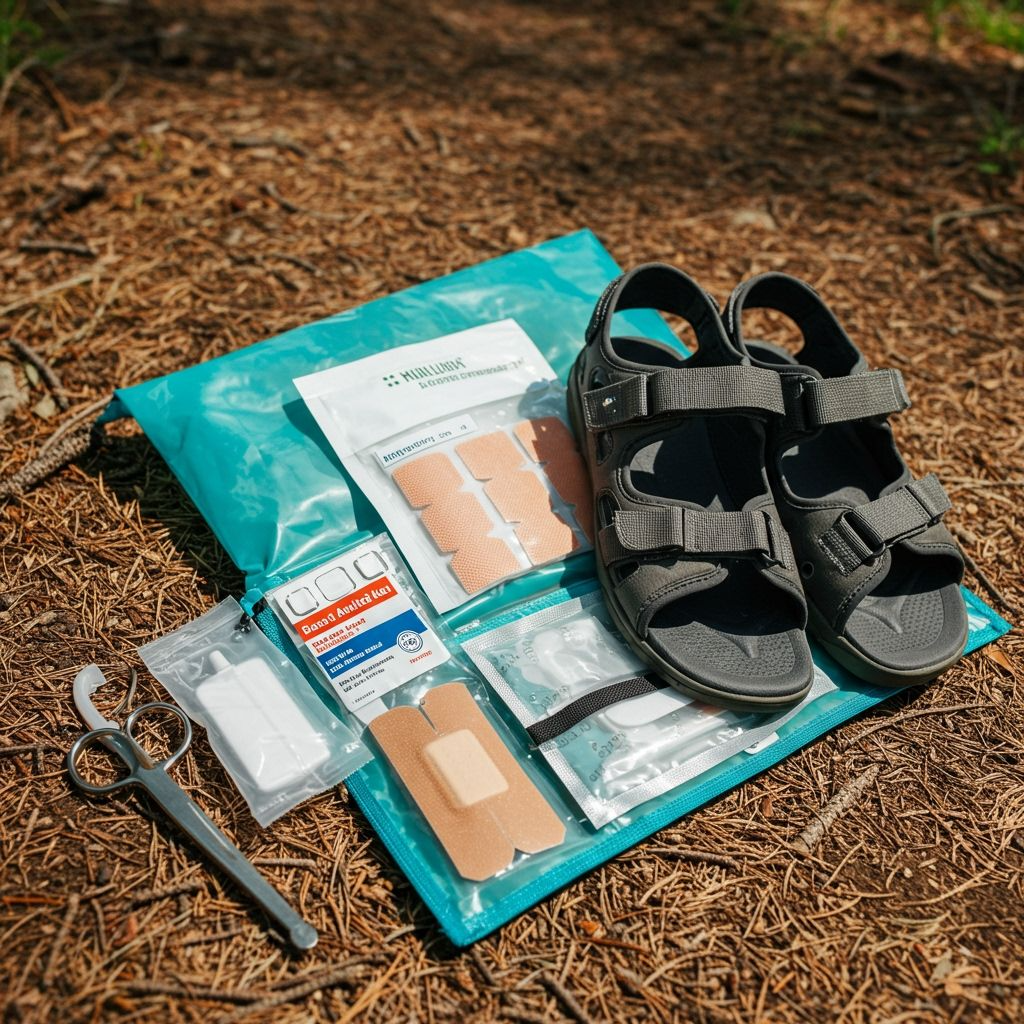
Advanced Barefoot Hiking Techniques
Terrain Reading and Foot Placement
Developing expert terrain reading skills separates casual barefoot walkers from accomplished barefoot hikers. This skill requires practice, patience, and systematic development of visual assessment abilities.
Learn to identify safe stepping zones by recognizing surface characteristics:
- Stable soil that won’t shift under weight appears packed and slightly darker
- Safe rock surfaces show evidence of weathering without sharp edges or loose materials.
- Root systems that provide a secure footing versus those that might shift or break
- Vegetation patterns that indicate ground stability and potential hazards
Develop efficient scanning patterns that allow continuous terrain assessment without constant downward focus:
- Primary scan: 6-10 feet ahead for major obstacles and route planning
- Secondary scan: 2-3 feet ahead for immediate foot placement decisions
- Peripheral awareness: General trail conditions and environmental factors
Master different foot placement techniques for various terrain types:
- Probe stepping: Testing questionable surfaces with partial weight before committing
- Edge walking: Using the sides of trails where vegetation provides softer surfaces
- Rock hopping sequences: Planning multi-step routes across challenging terrain
- Adaptive gait: Adjusting stride length and foot angle for optimal traction and comfort
Weather and Seasonal Adaptations
Barefoot hiking techniques must adapt to changing weather and seasonal conditions that dramatically affect both safety and comfort.
Hot weather strategies:
- Early morning starts to avoid peak surface temperatures
- Shade seeking during midday heat when surfaces become dangerous.
- Creek walking, where streams provide cooling and soft sandy bottoms.
- Frequent breaks on cool surfaces to prevent thermal injury
- Hydration focus as feet contribute significantly to body cooling.
Cold weather considerations:
- Gradual adaptation to cold surfaces to prevent frostbite
- Movement maintenance to preserve circulation and warmth
- Dry conditions preference as wet feet in cold weather create hypothermia risks.
- Emergency warming techniques, including snow removal and warming protocols
Wet conditions management:
- Traction awareness on slippery surfaces like wet rocks or roots
- Visibility reduction makes hazard identification more difficult.
- Skin softening from prolonged moisture exposure increases injury risk.
- Post-hike care, including thorough drying and inspection for problems
Building Advanced Skills
Experienced barefoot hikers develop specialized techniques that allow safe travel on increasingly challenging terrain:
Balance and agility training:
- Slackline walking to develop dynamic balance skills
- Rock scrambling practice on safe, known routes
- Yoga and movement practices that enhance body awareness and flexibility
- Trail running transitions for experienced practitioners seeking greater challenges
Sensory development:
- Night walking practice on familiar, safe trails to enhance non-visual senses
- Texture identification games that improve tactile sensitivity
- Temperature tolerance training through gradual exposure to various conditions
- Proprioceptive challenges like closed-eye balance work
Environmental expertise:
- Regional plant and hazard identification for local hiking areas
- Seasonal pattern recognition that informs timing and route choices
- Weather interpretation skills for making safe barefoot hiking decisions
- Leave No Trace principles adapted for barefoot hiking impact.
For those interested in developing comprehensive outdoor skills that complement advanced barefoot hiking, our How to Train for Hiking guide covers physical conditioning and skill development for all types of hiking challenges.
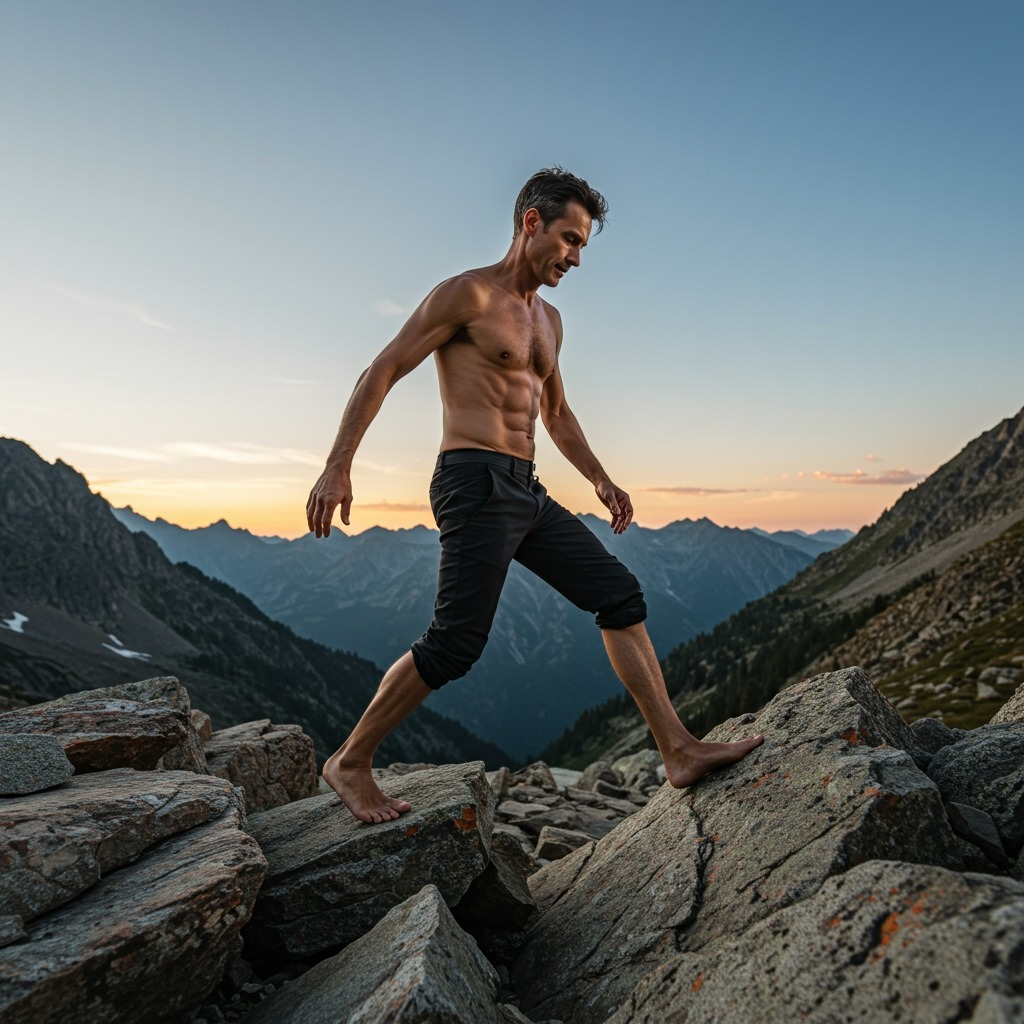
The Health Benefits of Barefoot Hiking
Physical Health Improvements
Regular barefoot hiking provides measurable health benefits that extend far beyond simple foot strengthening, affecting your entire kinetic chain and overall physical condition.
Improved foot and ankle strength develops through constant engagement of stabilizing muscles:
- Intrinsic foot muscles strengthen to provide natural arch support
- Ankle stability improves through constant proprioceptive feedback.
- Calf muscle development, as these become the primary shock absorbers
- Toe strength and mobility restore natural gripping and balance functions.
Postural improvements result from better foot mechanics:
- Spinal alignment improves as the feet provide a better foundation
- Hip stability increases through improved ground reaction forces.
- Core engagement naturally increases to maintain balance on varied terrain.
- Shoulder and neck tension often decreases as overall posture improves.
Cardiovascular benefits emerge from the enhanced physical demands:
- Increased caloric expenditure from engaging stabilizing muscles
- Improved circulation through natural foot pump mechanisms
- Enhanced proprioceptive training provides a nervous system workout.
- Better overall conditioning from full-body engagement requirements
Mental Health and Mindfulness Benefits
Barefoot hiking provides unique psychological benefits that complement the physical advantages, creating a holistic wellness practice.
Enhanced mindfulness naturally develops from the required attention to foot placement and terrain:
- Present moment awareness increases as you focus on immediate sensations
- Reduced mental chatter as attention shifts to physical awareness
- Deeper nature connection through direct contact with the earth’s surface
- Stress reduction through grounding and meditative movement
Confidence building occurs through mastering challenging skills:
- Problem-solving abilities develop through terrain navigation challenges
- Risk assessment skills improve through constant safety evaluation.
- Physical self-efficacy increases as foot strength and awareness develop.
- Connection to ancestral movement patterns provides psychological grounding.
Sensory awakening offers rich experiential benefits:
- Tactile sensitivity returns after years of shoe-numbed feet
- Temperature awareness provides immediate environmental feedback.
- Texture appreciation adds richness to outdoor experiences.
- Balance confidence improves through enhanced proprioception.
Therapeutic Applications
Healthcare professionals increasingly recognize barefoot activity as beneficial for various conditions, though medical guidance is essential for specific applications.
Plantar fasciitis and arch pain may benefit from gradual barefoot strengthening:
- Natural arch strengthening reduces dependence on artificial support
- Improved foot mechanics address underlying movement dysfunction.
- Reduced heel strike impact decreases inflammation triggers.
- Enhanced flexibility through natural foot movement patterns
Balance and stability issues often improve with barefoot training:
- Proprioceptive enhancement provides better fall prevention
- Ankle stability development reduces injury risk.
- Core strengthening through natural balance challenges
- Confidence-building in varied terrain navigation
Chronic pain conditions may find relief through better movement patterns:
- Knee and hip pain reduction through improved biomechanics
- Lower back pain relief from a better postural foundation
- Neck and shoulder tension decrease through overall alignment improvements.
- Circulation improvements from natural foot pump mechanisms
However, certain conditions require caution or medical clearance:
- Diabetes with neuropathy increases injury risk due to reduced sensation
- Peripheral vascular disease impairs healing and circulation.
- Severe arthritis may make barefoot activity too painful initially.
- Previous foot injuries require evaluation before beginning barefoot programs.
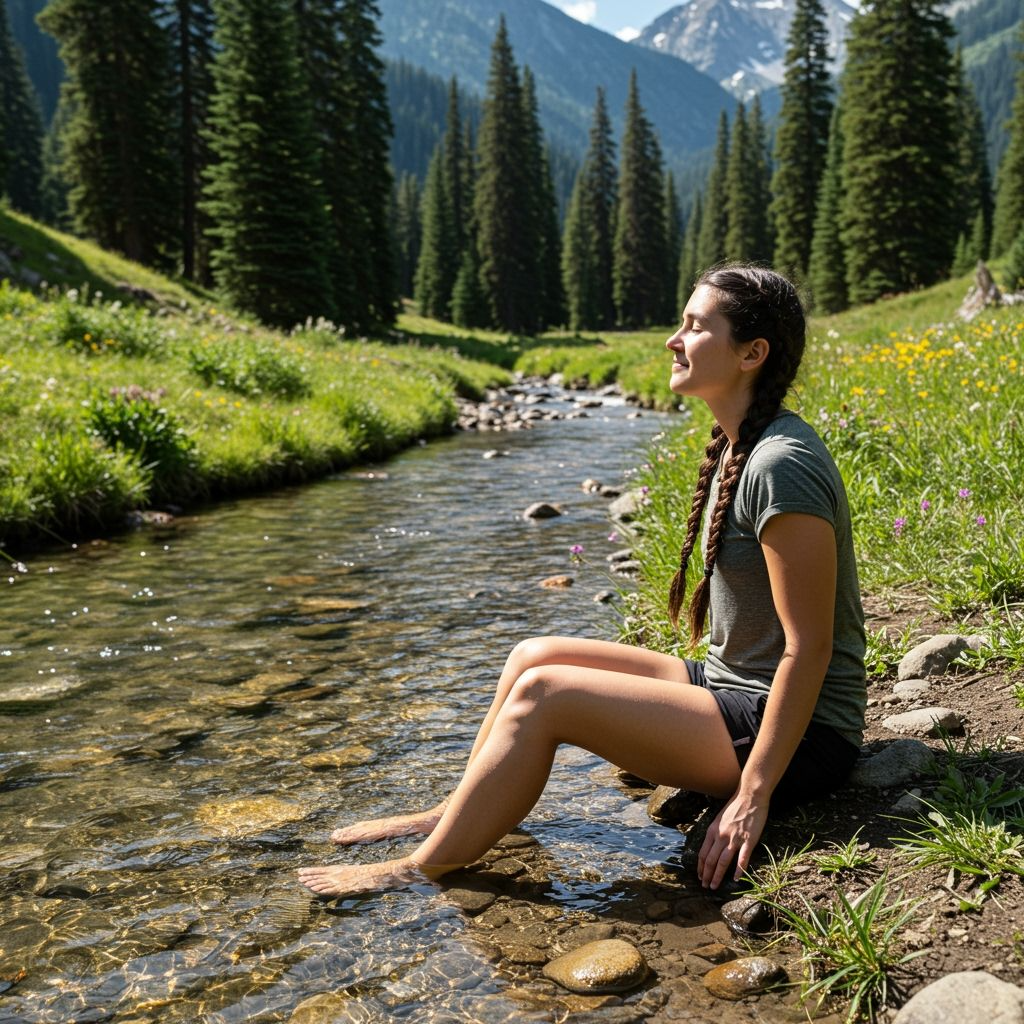
Regional Considerations and Trail Selection
Ideal Barefoot Hiking Destinations
Certain regions and trail types naturally lend themselves to barefoot hiking, offering optimal conditions for safe and enjoyable experiences.
Pacific Northwest trails provide excellent barefoot hiking opportunities:
- Soft forest floors with decades of accumulated needle and leaf litter
- Moss-covered surfaces that provide natural cushioning
- Moderate temperatures during hiking season
- Creek crossings offer cooling and cleaning opportunities.
- Well-maintained trails with minimal debris and hazards
Eastern deciduous forests offer seasonal barefoot hiking:
- Spring conditions with soft soil and emerging vegetation
- Fall leaf litter provides natural cushioning layers.
- Moderate climate during traditional hiking seasons
- Established trail systems with predictable maintenance standards
Coastal environments provide unique barefoot experiences:
- Beach hiking on sand offers natural foot conditioning
- Tidal pool exploration combines adventure with foot therapy.
- Dune systems provide varied terrain for skill development.
- Moderate temperatures year-round in many coastal areas
Desert regions require advanced skills but offer unique experiences:
- Winter hiking when temperatures are moderate
- Sand and soft soil in appropriate areas
- Unique sensory experiences with varied terrain types
- Clear visibility of potential hazards
International Barefoot Hiking Culture
Several countries have embraced barefoot hiking as a legitimate recreational activity with dedicated infrastructure and cultural support.
Switzerland’s barefoot trail network includes over 50 dedicated barefoot hiking routes:
- Marked trails with safety information and hazard management
- Varied terrain designed for progressive skill development
- Cultural acceptance with widespread community support
- Tourism integration, including barefoot-friendly accommodations
Germany’s barfusspfad movement has created hundreds of barefoot parks and trails:
- Educational components teaching foot health and natural movement
- Family-friendly designs accommodating all skill levels
- Therapeutic applications integrated with healthcare systems
- Community involvement in trail creation and maintenance
Austria’s barefoot hiking culture emphasizes connection with alpine environments:
- Mountain barefoot trails at various elevations and difficulty levels
- Seasonal programming adapted to alpine conditions
- Professional guidance available through certified instructors
- Integration with wellness tourism, including spa and health resort partnerships
Creating Local Barefoot Opportunities
You can develop barefoot hiking opportunities in your local area through careful planning and community engagement.
Scout potential routes by identifying:
- Safe terrain with minimal hazards and appropriate surfaces
- Access points with parking and basic facilities
- Property ownership and permission requirements
- Seasonal considerations for optimal conditions
Build community interest through:
- Educational presentations about barefoot hiking benefits and safety
- Group outings with experienced leaders for skill development
- Social media groups to coordinate activities and share information
- Partnership with outdoor organizations for broader community support
Work with land managers to:
- Discuss barefoot hiking policies and any restrictions
- Volunteer for trail maintenance to build positive relationships
- Provide educational materials about responsible barefoot hiking practices.
- Document environmental impact to demonstrate responsible use
For comprehensive information about discovering and developing local outdoor opportunities, our best cities for hiking guide provides insights into finding and creating urban and suburban hiking opportunities.
Equipment and Minimalist Gear Approach
Essential Barefoot Hiking Gear
Barefoot hiking requires specialized equipment focused on safety, emergency preparedness, and minimal environmental impact rather than traditional hiking gear priorities.
Enhanced first aid capabilities:
- Comprehensive foot care kit with multiple bandage types and sizes
- High-quality tweezers for splinter and thorn removal
- Antiseptic supplies appropriate for field wound treatment
- Emergency medications, including pain relief and anti-inflammatory options
- Emergency communication device for remote area safety
Emergency footwear options:
- Ultralight sandals that pack small but provide adequate protection
- Minimalist shoes for emergency protection without excessive weight
- Protective socks as intermediate protection for questionable surfaces
- Duct tape and padding for field-expedient foot protection
- Gaiters or protective covers for vegetation and debris protection
Specialized accessories:
- Trekking poles for enhanced balance and reduced foot pressure
- Headlamp or flashlight for careful terrain inspection in low light
- Small tarp or sit pad for comfortable rest stops.
- Water filtration as creek walking and foot washing, increases water needs
- Lightweight chair or stool for comfortable gear management and foot care
Minimalist Philosophy Integration
Barefoot hiking naturally aligns with minimalist outdoor philosophies that emphasize skill over gear and connection over consumption.
Weight reduction benefits:
- Eliminating boot weight can save 2-4 pounds from base pack weight
- Reduced sock and foot care products streamline packing lists.
- Simplified clothing systems with foot ventilation eliminate moisture issues.
- Enhanced mobility from reduced pack weight improves the overall hiking experience.
Skill development emphasis:
- Terrain reading abilities replace reliance on protective footwear
- Balance and proprioception substitute for artificial stability features
- Weather awareness becomes more critical for safe travel.
- Route-finding skills develop as surface evaluation becomes crucial.
Environmental connection:
- Direct earth contact enhances sensory experience and nature connection
- Reduced gear dependence allows greater focus on the natural environment.
- Simplified decision-making removes complex footwear choices from planning.
- Enhanced weather sensitivity increases awareness of natural conditions.
Maintenance and Care Protocols
Proper foot care becomes critical for barefoot hikers, requiring attention to hygiene, conditioning, and injury prevention.
Daily care routines:
- Thorough foot inspection for cuts, abrasions, or developing problems
- Cleaning protocols to prevent infection and remove debris
- Moisturizing to prevent cracking while maintaining appropriate callus development
- Nail maintenance to prevent ingrown nails and injury from overgrowth
Conditioning programs:
- Progressive surface exposure to build appropriate callus thickness
- Strength training for intrinsic foot muscles and lower leg development
- Flexibility maintenance through stretching and mobility work
- Balance training to enhance proprioceptive skills and stability
Recovery protocols:
- Post-hike care, including thorough cleaning and inspection
- Rest and recovery, allowing adaptation between hiking sessions.
- Problem identification and early intervention for developing issues
- Professional consultation when problems exceed self-care capabilities
For additional insights into minimalist approaches to outdoor activities, our primitive camping guide explores low-impact wilderness practices that complement barefoot hiking philosophy.
Building the Barefoot Hiking Community
Finding Like-Minded Adventurers
The barefoot hiking community is small but passionate, with members eager to share knowledge and experiences with newcomers to the practice.
Online communities provide valuable resources:
- Dedicated barefoot hiking forums offer technique discussions and safety advice
- Social media groups coordinate local meetups and share trail recommendations.
- Regional Facebook groups help find hiking partners and local expertise.
- YouTube channels provide visual instruction and inspiration.
- Blogs and websites document experiences and provide detailed guidance.
Local meetup opportunities:
- Barefoot walking groups in urban areas often organize trail outings
- Hiking clubs may have members interested in barefoot exploration.
- Outdoor gear stores sometimes host educational events and group activities.
- Running stores focusing on minimalist and barefoot running often know local practitioners.
- Yoga studios and wellness centers may have clients interested in barefoot hiking.
Educational Outreach and Advocacy
Responsible barefoot hiking advocacy helps build understanding and acceptance while promoting safe practices.
Educational opportunities include:
- Presentation to hiking clubs about the benefits and proper techniques
- Demonstration hikes for curious outdoor enthusiasts
- Safety workshops focusing on risk management and first aid
- Environmental education about minimal impact practices
- Skills sharing with experienced practitioners, mentoring newcomers
Responsible representation:
- Emphasize safety and preparation rather than risk-taking attitudes
- Demonstrate proper technique and conservative progression approaches.
- Share both benefits and limitations honestly with interested parties.
- Promote environmental responsibility and Leave No Trace principles.
- Acknowledge when barefoot hiking is inappropriate for conditions or individuals.
Future of Barefoot Hiking
Growing interest in natural movement and minimal footwear suggests continued expansion of barefoot hiking participation.
Positive trends include:
- Increased research into barefoot benefits and safety protocols
- Trail infrastructure development in progressive outdoor communities
- Professional instruction availability through certified movement specialists
- Medical community recognition of therapeutic applications
- Gear development focused on emergency protection and safety enhancement.
Challenges to address:
- Liability concerns from land managers and insurance providers
- Safety perception among traditional outdoor communities
- Skill development requirements that exceed many hikers’ commitment levels
- Seasonal and regional limitations that restrict year-round participation
- Medical contraindications that make barefoot hiking inappropriate for some individuals
For comprehensive information about barefoot hiking safety, techniques, and community resources, consult authoritative sources including PopSci’s barefoot hiking guide, Eurohike’s technique recommendations, and Adventure Hacks’ health benefits analysis.
Barefoot hiking offers a unique pathway to enhanced outdoor experiences, improved physical health, and a deeper nature connection. While not appropriate for every hiker or every situation, those who embrace this practice often find that it transforms their relationship with both their bodies and the natural world.
The key to success lies in patient progression, thorough preparation, and honest assessment of personal capabilities and limitations. Start conservatively, build skills gradually, and always prioritize safety over achievement. With a proper approach and adequate preparation, barefoot hiking can become a lifetime practice that enhances every aspect of your outdoor adventures.
Whether you pursue barefoot hiking as physical therapy, spiritual practice, or simply adventure enhancement, the journey begins with a single step—and the wisdom to know when and where to take that step safely.
Frequently Asked Questions
How long does it take to develop tough enough feet for barefoot hiking?
Most people need 2-4 weeks of regular barefoot walking to develop basic foot conditioning, and 2-3 months for significant callus development and strength building. The timeline varies greatly based on starting fitness, surface exposure, and individual adaptation rates.
What surfaces are best for learning barefoot hiking?
Begin with soft grass, pine needle paths, sandy trails, and smooth dirt surfaces. Avoid rocky terrain, areas with debris, extremely hot surfaces, and trails with thorns or aggressive vegetation until you develop advanced skills and foot conditioning.
Should I carry shoes when barefoot hiking?
Yes, always carry lightweight emergency footwear like sandals or minimalist shoes. Weather can change, terrain can become unsuitable, or injuries can occur that make barefoot travel unsafe or impossible.
Can barefoot hiking help with foot problems like plantar fasciitis?
Some people find barefoot activity helps strengthen feet and improve mechanics, potentially reducing certain foot problems. However, this varies greatly by individual, and you should consult healthcare providers before using barefoot hiking to address medical conditions.
